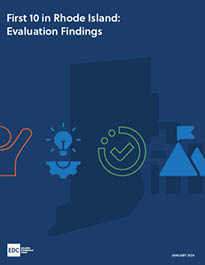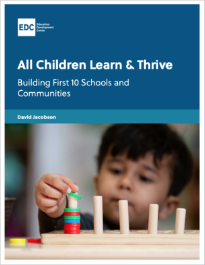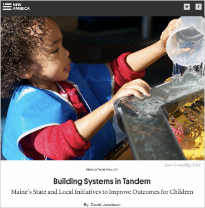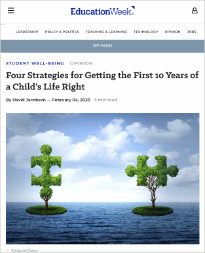Explore a collection of key introductory resources on First 10 to learn how First 10 works to support school-community partnerships in improving outcomes for thousands of children.
This report shares findings from an evaluation of First 10 implementation in Rhode Island, specifically in the communities of East Providence, Johnston, and Woonsocket. It assesses each communities’ progress toward their goals; shares feedback on team collaboration and relationships; describes sustainability plans; and offers formative feedback to improve First 10 and RIDE support.

This evaluation brief by the American Institutes for Research® (AIR®) shares findings from the first year of implementation in Michigan communities. First 10 pilot sites addressed barriers that limit families’ access to school readiness services; aligned pre-K and Kindergarten practices; and improved collaboration among schools, early childhood programs, and community partners; among other successes.

This study examines First 10 Schools and Communities—coordinated efforts taking place around the country to improve teaching, learning, and care during the first decade of children’s lives. First 10 Schools and Communities bring together school districts, elementary schools, and early childhood programs to improve the quality of education and care for young children and their families. They work to improve teaching and learning, deepen partnerships with families, and provide comprehensive services for children and families. First 10 initiatives take two basic forms: First 10 School Hubs are anchored by a single elementary school, which provides direct support to families and collaborates with nearby early childhood providers. First 10 Community Partnerships bring together multiple elementary schools, school district leaders, and early childhood programs to improve the quality and coordination of early childhood education and care throughout a geographic area or community.

Maine chose to use the First 10 framework to guide and structure an inter-agency team and a companion initiative in 13 communities throughout the state. First 10 partnerships bring together school districts, elementary schools, early childhood programs, and community agencies to improve the quality and coordination of education and care for young children and their families. They work to improve teaching and learning, deepen partnerships with families, and provide comprehensive services for children and families. David Jacobson provided technical assistance to Maine’s state and local teams in support of this initiative.

Over the past decade, David Jacobson has had the opportunity to research and work with communities that are attempting to bridge the divides thwarting efforts to improve outcomes for low-income children and their families. Read about four strategies that can help get the first 10 years of children’s lives right.

In many cities and towns across the United States, elementary schools are forging deeper partnerships with families and community organizations well before children arrive at kindergarten. The aim of this work is to improve children’s experiences and family engagement and support along the entire continuum from prenatal care through grade 3 and beyond. This potent combination of educational supports and family services is the single best strategy we have to address pernicious opportunity gaps and raise achievement for low-income children. Communities such as Cincinnati, Ohio; Omaha, Neb., and Multnomah County, Ore., are embracing this approach to tackle persistent poverty, family instability, the hollowing out of the middle class, and the demand for a more highly skilled workforce.

Education policy has become as polarized as the rest of American politics. In the new administration, disagreements over standards, funding, school choice, and students’ civil rights are sure to intensify. Yet despite this polarized state of affairs, liberal and conservative education priorities are converging in a number of important respects, driven in part by mounting research findings. Common ground is emerging where conservative commitments to character formation, strong families, and local solutions meet liberal commitments to services that help low-income families overcome obstacles to improving their quality of life. Borrowing a term from the Harvard political scientist Robert Putnam, David Jacobson suggests that a number of educational priorities, described below, are “purple”—they resonate with both red and blue constituencies. Further, these priorities animate a powerful reform movement that is spreading across the country.
